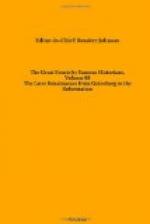Queen Isabella, horrified at the murder of her confessor—for “confessor of the kings” was an honorary dignity conferred on each inquisitor in Spain—erected a monument to his memory at her own expense; and when the murders perpetrated by Arbues himself had somewhat faded out of public memory, he was beatified at Rome, and a chapel was constructed for his veneration in the church where he had fallen. Therein his remains were laid; and over the spot where he received the mortal blow a stone was placed, with the inscription: “Siste, viator,” etc. “Stay, traveller! Thou adorest the place (locum adoras) where the blessed Pedro de Arbues was laid low by two missiles. Epila gave him birth. This city gave him a canonry. The apostolic see elected him to be the first Father Inquisitor of the Faith. Because of his zeal he became hateful to the Jews; by whom slain, he fell here a martyr in the year 1485. The most serene Ferdinand and Isabella reared a marble mausoleum, where he became famous for miracles. Alexander VII, Pontifex Maximus, wrote him into the number of holy and blessed martyrs on the 17th day of April in the year 1664. The tomb having been opened, the sacred ashes were translated, and placed under the altar of the chapel (built by the chapter, with the material of the tomb, in the space of sixty-five days), with solemn rite and veneration, on the 23d day of September, in the year 1664.”
The intelligence of that murder threw all Aragon into commotion. The powers, ecclesiastical and royal, panted for vengeance, and the murderers were put to a most painful death. The Jews and New Christians trembled with terror and rage. The inhabitants of many towns, Teruel, Valencia, Lerida, and Barcelona included, compelled the inquisitors to cease from inquest; and it was only by means of military force, after edicts and bulls had failed, that the King and Pope together could quash two years’ public resistance. In Saragossa, where the murder had been contrived by a party of chief inhabitants, a consciousness of guilt weakened their hands and they endeavored to save themselves by flight. Thousands of people deserted the city, although they had no participation in the deed and were everywhere treated as rebels; and in that migration incidents occurred which might throw a tinge of horrible romance on our history. Let me briefly mention two.
An inhabitant of Saragossa found his way to Tudela, and there begged for shelter and concealment in the house of Don Jaime, Infante of Navarre, legitimate son of the Queen of Navarre and nephew of King Ferdinand himself. The Infante could not refuse asylum and hospitality to an innocent fugitive. He allowed the man to hide himself for a few days and then pass on to France. For this act of humanity Don Jaime was arrested by the inquisitors, thrown into prison as an impeder of the Holy Office, brought thence to Saragossa, a place quite beyond the jurisdiction of Navarre, and there made to do open penance in the cathedral, in presence of a great congregation at high mass. And what penance! The Archbishop of Saragossa presided; but this Archbishop was a boy of seventeen, an illegitimate son of the King; and he it was that commanded two priests to flog his father’s lawful nephew, the Infante of Navarre, with rods. They whipped Don Jaime around the church accordingly.




